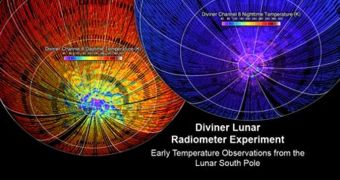When someone begins to wonder where the coldest place in our immediate surrounding is, the Moon is not the first place to come to mind. But measurements taken with the Diviner Lunar Radiometer Experiment (DLRE) instrument, aboard NASA's Lunar Reconnaissance Orbiter (LRO), proved that, for now, the coldest place in the solar system could be found near the Moon's South Pole. The announcement was made today, at a conference organized by the American space agency, ScienceNow reports.
Permanently shadowed craters in the lunar region sport extremely low temperatures, just some 33 degrees above absolute zero (0 Kelvin, -273.15 Celsius). The good news about the find is that such low temperatures offer the required conditions for water-ice to exist on the surface of the Earth's natural satellite. These resources could prove invaluable to future manned exploration missions, and could provide astronauts with a steady supply of water for the duration of their mission.
Other instruments aboard the LRO managed to recently provide intriguing results in their assessments of the Moon's surface. Some discovered traces that were associated with the possible existence of liquid-water, or maybe even hydrogen, in the same southern regions. However, every scientist that was present at NASA's conference said that more data were definitely needed before a final conclusion could be drawn, and reminded attendants that these results were preliminary.
The recent data collected by the Lunar Exploration Neutron Detector (LEND) spectrometer, another one of LRO's instruments, shows that traces of hydrogen can be seen even in regions of the Moon that are definitely not frozen. For instance, at one location, daytime temperatures were as high as 380 degrees Kelvin. This brings to mind the conclusion that these particular deposits of hydrogen may have nothing to do with water after all. When questioned about this peculiarity, the Principal Investigator of the Diviner instrument, David Paige, said, “I have no comment. I take a wait-and-see attitude.”
Lunar Orbiter Laser Altimeter (LOLA) measurements of the South Pole have also indicated that it will be far harder to explore the region than first thought. The LRO instrument, which precisely maps elevation in the areas it analyzes, has found that the terrain is very rough, and that astronauts and vehicles deployed there will need special hardware to cope with the terrain. One of the orbiter's main purposes is to find places suitable for human landings, as NASA's plans are to send people back on the satellite by 2020. The probe also needs to create the first full maps of the Moon.

 14 DAY TRIAL //
14 DAY TRIAL //